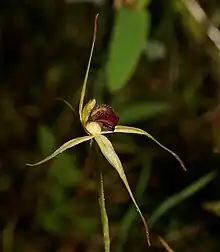| Genoa spider orchid | |
|---|---|
 | |
| Scientific classification | |
| Kingdom: | Plantae |
| Clade: | Tracheophytes |
| Clade: | Angiosperms |
| Clade: | Monocots |
| Order: | Asparagales |
| Family: | Orchidaceae |
| Subfamily: | Orchidoideae |
| Tribe: | Diurideae |
| Genus: | Caladenia |
| Species: | C. ancylosa |
| Binomial name | |
| Caladenia ancylosa | |
| Synonyms[1] | |
|
Arachnorchis ancylosa D.L.Jones | |
Caladenia ancylosa, commonly known as the Genoa spider orchid,[2] is a plant in the orchid family Orchidaceae and is endemic to Victoria. It is a ground orchid with a single hairy leaf and a single cream-coloured flower with red markings.
Description
Caladenia ancylosa is a terrestrial, perennial, deciduous, herb with an underground tuber and a single hairy leaf, 6–12 cm (2–5 in) long and 5–10 mm (0.2–0.4 in) wide.[3][4]
A single flower is borne on a spike 12–25 cm (5–10 in) high. The dorsal sepal is erect, oblong to lance-shaped, 25–40 mm (1–2 in) long and about 3 mm (0.1 in) wide. It tapers near the end which terminates in a glandular structure 7–10 mm (0.3–0.4 in) long. The lateral sepals are oblong to lance-shaped, 25–40 mm (0.98–1.6 in) long, 3.5–4.5 mm (0.14–0.18 in) wide and end in a gland similar to the one on the dorsal sepal. The petals are 20–25 mm (0.8–1 in) long, about 2 mm (0.08 in) wide and taper to a point. The labellum is a broad egg-shape, curves forward, 10–13 mm (0.4–0.5 in) long and 7–9 mm (0.3–0.4 in) wide when flattened. The labellum is cream-coloured at its base but red nearer the tip. There are 7 to 10 pairs of calli along the edge of the labellum, decreasing in length towards its front. There are six rows of foot-shaped calli in the centre of the labellum, also smaller towards the tip. Flowering occurs in September and October.[4]
Taxonomy and naming
The species was first formally described by David L. Jones in 2006 and given the name Arachnorchis ancylosa.[5] The description was published in Australian Orchid Research. In 2007, Gary N. Backhouse transferred the species to Caladenia as C. ancylosa and the change was published in The Victorian Naturalist.[6] Jones derived the specific epithet (ancylosa) "from the Greek ancylosis, stiffening of the joints; in reference to the stiffly spreading lateral sepals and petals".[3]
Distribution and habitat
Caladenia ancylosa is only known from far east Gippsland where it grows in the shrub layer of tall open forest near Genoa.[4]
Conservation
This species is classified as "Vulnerable" by the Victorian government.[4][2]
References
- 1 2 "Caladenia ancylosa". Australian Plant Census. Retrieved 21 November 2023.
- 1 2 "Advisory list of rare and threatened plants in Victoria 2014" (PDF). The State of Victoria Department of Environment and Primary Industries. Retrieved 28 September 2016.
- 1 2 Jones, David L. (2006). "New taxa of Australian Orchidaceae". Australian Orchid Research. 5: 51–52.
- 1 2 3 4 Jeanes, Jeffrey. "Caladenia ancylosa". Royal Botanic Gardens Victoria: Vicflora. Retrieved 28 September 2016.
- ↑ "Arachnorchis ancylosa". APNI. Retrieved 28 September 2016.
- ↑ "Caladenia ancylosa". APNI. Retrieved 28 September 2016.